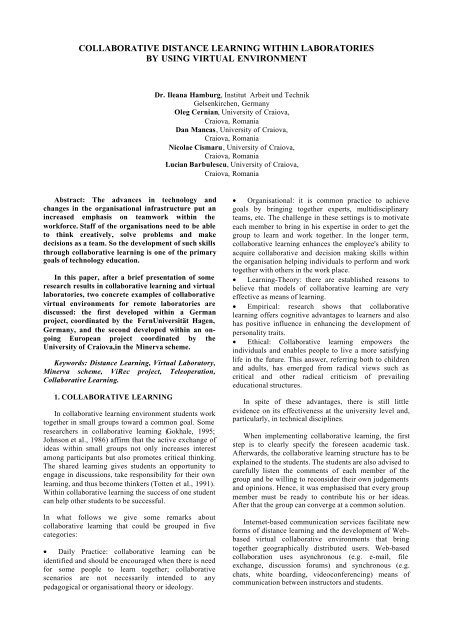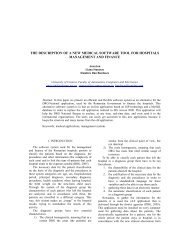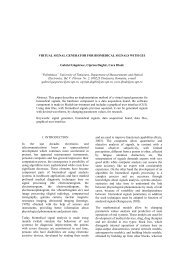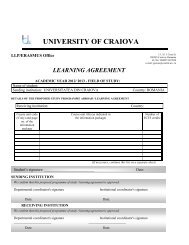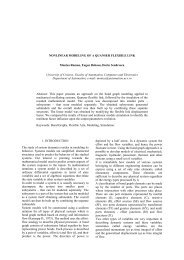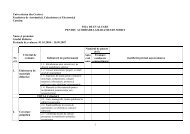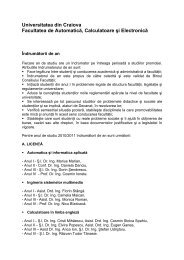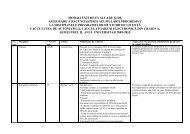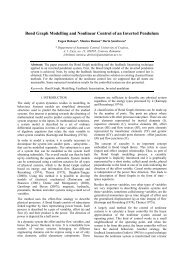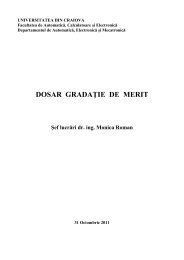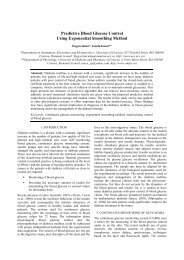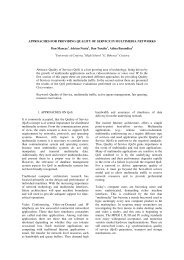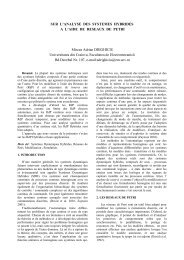collaborative distance learning within laboratories by using virtual ...
collaborative distance learning within laboratories by using virtual ...
collaborative distance learning within laboratories by using virtual ...
Create successful ePaper yourself
Turn your PDF publications into a flip-book with our unique Google optimized e-Paper software.
COLLABORATIVE DISTANCE LEARNING WITHIN LABORATORIES<br />
BY USING VIRTUAL ENVIRONMENT<br />
Dr. Ileana Hamburg, Institut Arbeit und Technik<br />
Gelsenkirchen, Germany<br />
Oleg Cernian, University of Craiova,<br />
Craiova, Romania<br />
Dan Mancas, University of Craiova,<br />
Craiova, Romania<br />
Nicolae Cismaru, University of Craiova,<br />
Craiova, Romania<br />
Lucian Barbulescu, University of Craiova,<br />
Craiova, Romania<br />
Abstract: The advances in technology and<br />
changes in the organisational infrastructure put an<br />
increased emphasis on teamwork <strong>within</strong> the<br />
workforce. Staff of the organisations need to be able<br />
to think creatively, solve problems and make<br />
decisions as a team. So the development of such skills<br />
through <strong>collaborative</strong> <strong>learning</strong> is one of the primary<br />
goals of technology education.<br />
In this paper, after a brief presentation of some<br />
research results in <strong>collaborative</strong> <strong>learning</strong> and <strong>virtual</strong><br />
<strong>laboratories</strong>, two concrete examples of <strong>collaborative</strong><br />
<strong>virtual</strong> environments for remote <strong>laboratories</strong> are<br />
discussed: the first developed <strong>within</strong> a German<br />
project, coordinated <strong>by</strong> the FernUniversität Hagen,<br />
Germany, and the second developed <strong>within</strong> an ongoing<br />
European project coordinated <strong>by</strong> the<br />
University of Craiova,in the Minerva scheme.<br />
Keywords: Distance Learning, Virtual Laboratory,<br />
Minerva scheme, ViRec project, Teleoperation,<br />
Collaborative Learning.<br />
1. COLLABORATIVE LEARNING<br />
In <strong>collaborative</strong> <strong>learning</strong> environment students work<br />
together in small groups toward a common goal. Some<br />
researchers in <strong>collaborative</strong> <strong>learning</strong> (Gokhale, 1995;<br />
Johnson et al., 1986) affirm that the active exchange of<br />
ideas <strong>within</strong> small groups not only increases interest<br />
among participants but also promotes critical thinking.<br />
The shared <strong>learning</strong> gives students an opportunity to<br />
engage in discussions, take responsibility for their own<br />
<strong>learning</strong>, and thus become thinkers (Totten et al., 1991).<br />
Within <strong>collaborative</strong> <strong>learning</strong> the success of one student<br />
can help other students to be successful.<br />
In what follows we give some remarks about<br />
<strong>collaborative</strong> <strong>learning</strong> that could be grouped in five<br />
categories:<br />
• Daily Practice: <strong>collaborative</strong> <strong>learning</strong> can be<br />
identified and should be encouraged when there is need<br />
for some people to learn together; <strong>collaborative</strong><br />
scenarios are not necessarily intended to any<br />
pedagogical or organisational theory or ideology.<br />
• Organisational: it is common practice to achieve<br />
goals <strong>by</strong> bringing together experts, multidisciplinary<br />
teams, etc. The challenge in these settings is to motivate<br />
each member to bring in his expertise in order to get the<br />
group to learn and work together. In the longer term,<br />
<strong>collaborative</strong> <strong>learning</strong> enhances the employee's ability to<br />
acquire <strong>collaborative</strong> and decision making skills <strong>within</strong><br />
the organisation helping individuals to perform and work<br />
together with others in the work place.<br />
• Learning-Theory: there are established reasons to<br />
believe that models of <strong>collaborative</strong> <strong>learning</strong> are very<br />
effective as means of <strong>learning</strong>.<br />
• Empirical: research shows that <strong>collaborative</strong><br />
<strong>learning</strong> offers cognitive advantages to learners and also<br />
has positive influence in enhancing the development of<br />
personality traits.<br />
• Ethical: Collaborative <strong>learning</strong> empowers the<br />
individuals and enables people to live a more satisfying<br />
life in the future. This answer, referring both to children<br />
and adults, has emerged from radical views such as<br />
critical and other radical criticism of prevailing<br />
educational structures.<br />
In spite of these advantages, there is still little<br />
evidence on its effectiveness at the university level and,<br />
particularly, in technical disciplines.<br />
When implementing <strong>collaborative</strong> <strong>learning</strong>, the first<br />
step is to clearly specify the foreseen academic task.<br />
Afterwards, the <strong>collaborative</strong> <strong>learning</strong> structure has to be<br />
explained to the students. The students are also advised to<br />
carefully listen the comments of each member of the<br />
group and be willing to reconsider their own judgements<br />
and opinions. Hence, it was emphasised that every group<br />
member must be ready to contribute his or her ideas.<br />
After that the group can converge at a common solution.<br />
Internet-based communication services facilitate new<br />
forms of <strong>distance</strong> <strong>learning</strong> and the development of Webbased<br />
<strong>virtual</strong> <strong>collaborative</strong> environments that bring<br />
together geographically distributed users. Web-based<br />
collaboration uses asynchronous (e.g. e-mail, file<br />
exchange, discussion forums) and synchronous (e.g.<br />
chats, white boarding, videoconferencing) means of<br />
communication between instructors and students.
2. VIRTUAL LABORATORIES<br />
In engineering education, lectures are usually<br />
complemented <strong>by</strong> laboratory experimentation. Students<br />
can observe dynamic phenomena that usually are<br />
difficult to explain <strong>by</strong> written material. Furthermore,<br />
interactive experimentation on real world devices<br />
improves the motivation of the students and develops an<br />
engineering approach to solve realistic problems.<br />
But, in <strong>distance</strong> education, laboratory<br />
experimentation represents a complex task, as compared<br />
to the conventional form of education, where students<br />
can be present in the university labs. A solution to avoid<br />
this drawback is given <strong>by</strong> <strong>virtual</strong> experimentation that is<br />
the experiments are simulated and visualised <strong>by</strong> means<br />
of <strong>virtual</strong> reality. Simulation represents a proper way to<br />
complement engineering education, but, in general, it<br />
can not replace experiments on real devices.<br />
Another methodology to avoid the drawbacks of<br />
local conventional experimentation consists in<br />
teleoperation of laboratory experiments. Tele<strong>laboratories</strong><br />
are expressions of a more general <strong>distance</strong><br />
<strong>learning</strong> education which is attracting at present wide<br />
attention in the academic world and governmental<br />
communities.<br />
A thorough analysis of the concepts <strong>virtual</strong> labs and<br />
remote labs was carried out recently <strong>by</strong> Exel and<br />
collaborators (Exel et al., 2001) in a paper entitled<br />
"Simulation Workshop and Remote Laboratory: two<br />
web-based training approaches for control", where it is<br />
concluded that <strong>virtual</strong> labs are good for assimilating<br />
theory, but they cannot replace real processes, since a<br />
model is only an approximation which cannot reproduce<br />
all the aspects of a process. Providing remotely<br />
accessible experiments another advantage is obtained,<br />
when a unique or expensive equipment can be shared<br />
between several universities situated <strong>within</strong> one country<br />
or in different countries. In this way, a larger number of<br />
laboratory resources are available and students can<br />
choose from a variety of lab experiments.<br />
Teleoperated <strong>laboratories</strong> have applications in<br />
research or industry as well, like:<br />
• high school comprehensive usage of the<br />
<strong>laboratories</strong>,<br />
• directly comparison of the procedures,<br />
• demonstrations at conferences,<br />
• <strong>distance</strong> maintenance, telediagnosis,<br />
• embedded Web-services.<br />
Some requirements for teleoperated (<strong>distance</strong><br />
driven) laboratory experiments are the following:<br />
• teleaction,<br />
• telepresence,<br />
• recording and transmission of measured data,<br />
• security of the structure of the experiment,<br />
• protection of the access,<br />
• management of the access.<br />
When dealing with such kind of applications, it is<br />
important to transport the feeling of a real experiment to<br />
the remote user, a goal provided <strong>by</strong> a video and audio<br />
broadcast.<br />
As only a group of students at a time receives access<br />
to an individual experiment, schedules and exclusive<br />
access procedures to the experiment are necessary. Users<br />
should be able to book experimentation time in advance.<br />
They carry out the whole booking procedure <strong>by</strong><br />
themselves in order to choose the time most appropriate<br />
to their needs. The main requirement on the server side is<br />
the safety of the experiment and of the server. The<br />
experimental plant on the other hand has to be protected<br />
against any action that can damage or destroy it. For this<br />
reason, all commands given to the plant controller must<br />
be analysed and those dangerous controller settings have<br />
to be avoided. If the controller algorithms can be defined<br />
<strong>by</strong> the user without any restriction, system instabilities<br />
caused <strong>by</strong> the controller are difficult to be detected in<br />
advance. To evaluate students work, it is useful to log all<br />
communications between user and experimental<br />
environment.<br />
To provide remote experimentation to a group of<br />
students, typical synchronous communication techniques,<br />
like video-conferencing, are not suitable because of<br />
bandwidth limitations. A video-conference with more<br />
than two communication partners is a typical point-tomultipoint<br />
application. If a true collaboration of all<br />
partners is desired, the partner with the smallest<br />
bandwidth limits the communication. Our application of a<br />
remote lab requires real interaction between the students<br />
and the tutor, so a bandwidth-saving way of interaction is<br />
required as an alternative to the video based<br />
communication. Pure text-based communication (Chat)<br />
does not meet our requirements because a multi-user<br />
remote lab application needs the possibility of real<br />
interaction. The tutor has to be enabled to introduce and<br />
to explain the details of the experiment <strong>by</strong> some kind of<br />
visual representation of the experiment. In this<br />
<strong>collaborative</strong> <strong>virtual</strong> environment only one student at a<br />
time has active access to the experiment.<br />
3. EXAMPLES<br />
In what follows we give some examples of such<br />
developments. The main design idea of the remote<br />
experimentation systems used <strong>within</strong> such projects is to<br />
use the Web as communication structure and the Web<br />
browser as user interface. A Web Server is the interface<br />
between the client (student) and the experiment. A video<br />
and audio broadcast can provide the remote user with the<br />
feeling of being physically present at the location of the<br />
real experiment.<br />
Three German universities (University of Bochum,<br />
University of Dortmund, FernUniversität Hagen) are<br />
currently developing a <strong>virtual</strong> laboratory as a network of<br />
remotely accessible <strong>laboratories</strong>, in order to set up a<br />
prototype experimental environment. The students will<br />
have access via Internet to various experiments in control
engineering, which are physically situated in the control<br />
<strong>laboratories</strong> at these three universities. With remote<br />
experimentation unique or expensive equipment can be<br />
shared between different universities. Since a wider<br />
range of laboratory resources can be made accessible,<br />
the students have the choice between more experiments.<br />
They can use the <strong>virtual</strong> laboratory at any time and at<br />
any place and save travel time and cost.<br />
The software modules of the <strong>collaborative</strong><br />
environment for the <strong>virtual</strong> laboratory (Fig. 1) are<br />
generic and can be used in several remote experiments<br />
at German universities. The <strong>collaborative</strong> environment<br />
is divided into two main modules - a rendering and<br />
graphics part on the client side and a communication<br />
middleware on the server side. On the client side VRML<br />
is used to display the <strong>virtual</strong> 3D environment.<br />
Simulink environment (taught to students from<br />
Automation specialisation). Moreover, the ACT is<br />
accessible in a very easy way from every computer<br />
connected to the Internet through any browser, without<br />
the necessity to downloading any special software or<br />
plug-in.<br />
Another example refers to the project ”ViReC e-<br />
Initiative” – University Virtual Resource Centre based on<br />
a DLE (Distributed Learning Environment) – which<br />
represents an European dimension attempt for applying<br />
<strong>collaborative</strong> <strong>distance</strong> <strong>learning</strong> environments in higher<br />
education institutions. The project is financed <strong>by</strong><br />
European Commission <strong>within</strong> Socrates-Minerva<br />
programme. The partnership incorporates several<br />
universities and research institutions from four countries:<br />
Romania, Germany, Ireland and Greece. The major<br />
background for this application is represented <strong>by</strong> an<br />
initial experience approached <strong>by</strong> one of the partners –<br />
Fachhochschule Regensburg – consisting in setting up the<br />
Bavarian Virtual University, where an important<br />
contribution belongs to the teaching staff from the<br />
University of Craiova.<br />
Among several remarkable foreseen outputs, the<br />
creation of <strong>virtual</strong> <strong>laboratories</strong> crossed with some real<br />
equipment, represents a challenging achievement.<br />
Fig.1<br />
At present, partners are involved in individual<br />
developments concerned with some envisaged outputs<br />
planned as tutorials and exercises for remote labs in the<br />
fields of Network Security, Network Management,<br />
Computer Architecture and Data Base Systems (Fig. 2).<br />
An interesting development that can be pointed out<br />
belongs to an output of University of Sieni (Casini M, et<br />
al, 2003), where a remote laboratory of automatic<br />
control was set up. The main goal of the envisaged<br />
structure is to allow students to interact with a set of<br />
physical processes through the Internet. In this way, it is<br />
created a channel to drive the experiments from a lab<br />
remotely located, including changing of control<br />
parameters, analysing the results remotely etc. This<br />
automatic control telelab, called ACT, allows the<br />
student to design a particular controller <strong>by</strong> means of the<br />
MATLAB/ Simulink environment, and to test it on the<br />
actual plant through a user-friendly interface. ACT has a<br />
flexible architecture, allowing an easy integration of<br />
new processes for control experiments. The main<br />
features implemented <strong>by</strong> ACT are: activeness, full<br />
availability, instrumental easiness, easy interface,<br />
remote Simulink-based Controller design, easy addition<br />
of new processes, laboratory presence, reference<br />
change, on-line reference and controller parameter<br />
changes etc.<br />
Every experiment can be controlled according to two<br />
modes of operation, namely predefined and user<br />
defined, depending on the kind of the control laws<br />
chosen <strong>by</strong> the student. The main feature of the ACT is<br />
that a remote user can synthesize the controller without<br />
<strong>learning</strong> any special language excepting MATLAB/<br />
Fig. 2
The first tangible results are to be reported in<br />
autumn 2003 at a Workshop dedicated purposely to this<br />
goal.<br />
With regard to <strong>collaborative</strong> feature of projects it<br />
could be mentioned a successful recent development<br />
called IVDS - that is the International Virtual Design<br />
Studio. This project was carried out <strong>by</strong> a Consortium<br />
composed of the Union Collage (USA), Queen's<br />
University (Canada) and MEDU University (Turkey).<br />
The objective of IVDS is to provide a <strong>collaborative</strong><br />
design experience to students in different international<br />
locations (Notash L., 2003).<br />
The IVDS was created in 1996 <strong>by</strong> the Union Collage<br />
in Schenectady, NY, and Middle East Technical<br />
University in Ankara, in response to the need to develop<br />
the skills among students that are necessitating to<br />
complement the emerging global environment of today's<br />
workplace. After that in 1997 Queen's University of<br />
Kingston, Ontario, joined the project team.<br />
Eventually IVDS provides teams with international<br />
culture interaction and team building, long <strong>distance</strong><br />
project collaboration and communication, creative<br />
thinking, and project management experience.<br />
The work on IVDS project and its outcomes pertain<br />
to the area of geographically distributed student groups<br />
linked <strong>by</strong> Internet, to constitute multicultural design<br />
teams aiming to develop a creative thinking. It could be<br />
appreciated that IVDS is a remarking project since it<br />
includes both design and international components. The<br />
assessments show that the students find it a very<br />
positive experience where they work as international<br />
teams during which they learn many important issues<br />
related to design engineering. The IVDS allows students<br />
across the world to work together in engineering design<br />
projects, while challenged with cultural, educational<br />
differences.<br />
4. CONCLUSIONS<br />
Virtual laboratory experiments have many<br />
advantages, like a comprehensive usage <strong>by</strong> many<br />
universities, a bigger number of available experiments,<br />
a higher level valued experiments, that are independent<br />
of place and time, and are not requiring travel costs and<br />
time. Anyhow our experience with development of such<br />
laboratory shows that in order to be efficient they<br />
require more intensive advices, media competence of<br />
the tutors, live "presence" and feedback of the students<br />
about the <strong>laboratories</strong>. Collaboration and workgroup<br />
should be initiated <strong>by</strong> the tutor of the laboratory<br />
experiment and supported <strong>by</strong> <strong>collaborative</strong> exercises.<br />
REFERENCES<br />
Aktan, B.; Bohus, C.A.; Crowl, L.A.; Shor, M.H.<br />
(1999): Distance Learning Applied to Control<br />
Engineering Laboratories, IEEE Transactions on<br />
Education, Vol. 39, No. 3.<br />
Casini, M., Prattichizzo, D., Vicino. A.; (2003), The<br />
Automatic Control Telelab: A User-Friendly Interface<br />
for Distance Education, IEEE Transaction on Education,<br />
Vol. 46, 2003<br />
Cernian, O., Hamburg, I., Mancas, D. (2003)<br />
Distributed Learning Environments - Examples, Inforec<br />
magazine, ASE Bucharest<br />
Gokhale, A. (1995), Collaborative Learning Enhances<br />
Critical Thinking. Journal of Technology Education, 7, 1<br />
ISSN1045-1064<br />
Hamburg, I., Cernian, O., ten Thij, H. (2003): Lernen<br />
und Kooperieren in verteilten Umgebungen: die Chance<br />
für die betriebliche Weiterbildung! Engert, S., Hamburg,<br />
I. (Hrsg.): IT-basierte Lernformen für die betriebliche<br />
Weiterbildung. Gelsenkirchen: Inst. Arbeit und<br />
Technik, S. 45-55.<br />
Henry, J. (1996): Controls Laboratory Teaching via<br />
the World Wide Web. In Proc. ASEE Annual<br />
Conference, Washington, USA.<br />
Jochheim, A.; Röhrig, C. (1999): The Virtual Lab for<br />
Teleoperated Control of Real Experiments. In Proc. IEEE<br />
Conference on Decision and Control, Phoenix, USA<br />
Johnson, R.T., Johnson, D. W. (1986). Action<br />
research: Cooperative <strong>learning</strong> in the science classroom.<br />
Science and Children, 24, 31-32<br />
Notash, L., Garriock, M., 2003, International Virtual<br />
Design Studio (IVDS) Program: Overview, Challenges,<br />
and Students' Perspective, IEEE Transactions on<br />
Education, Vol. 43, 2003<br />
Röhrig, C., Jocheim , A. (2000): A Java-based<br />
Framework for Remote Access to laboratory<br />
Experiments. Proc. IFAC/IEEE Symposium on Advances<br />
in Control Education, Goald Coast, Australia.<br />
Schmid, C. (1999): A Remote Laboratory Using<br />
Virtual Reality on the Web, Simulation, Vol. 73, No. 1.<br />
Shirmohammadi, S.; Oliveira J.C.; Georganas, N.D.<br />
81998): Applet-Based Telecollaboration: A Networkcentric<br />
Approach. IEEE Multimedia, Vol. 5, No. 2, pp.<br />
64-73, 1998<br />
Totten, S., Sills, T., Dig<strong>by</strong>, A., Russ, P. (1991),<br />
Cooperative Learning: A guide to research. New York:<br />
Garland


